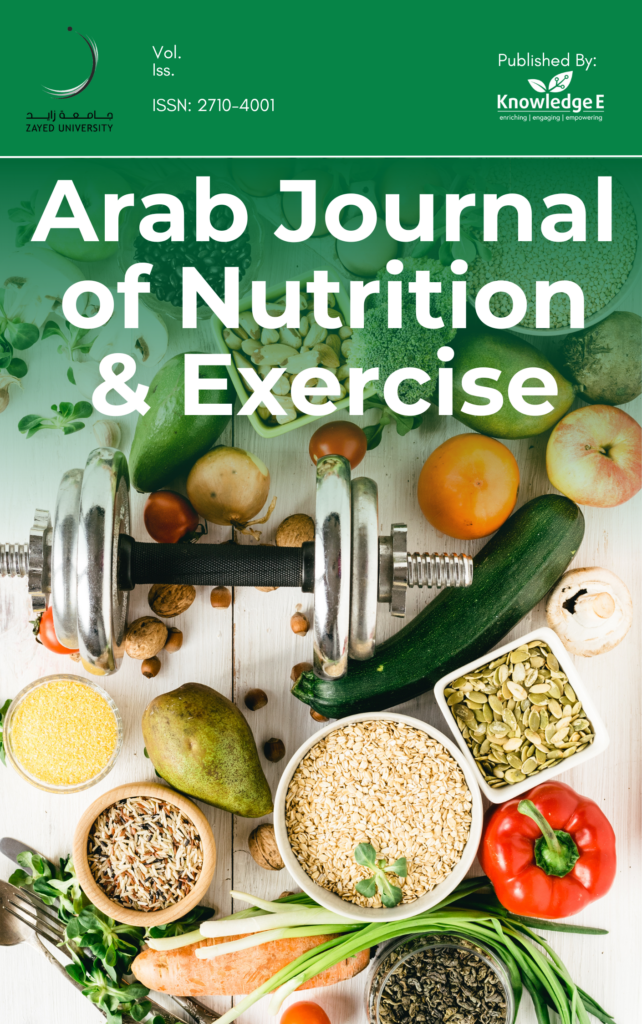
Arab Journal of Nutrition and Exercise
ISSN: 2518-6590
Groundbreaking research on nutrition, physical activity, and public health from across the Arab world.
Effect of Healthy Lifestyle Interventions in Schools of Jazan City, Kingdom of Saudi Arabia: A Quasi-experimental Study
Published date: Apr 30 2020
Journal Title: Arab Journal of Nutrition and Exercise
Issue title: AJNE: Vol 5, No 1 (2020)
Pages: 1-14
Authors:
Abstract:
Background
Unhealthy dietary habits and lifestyle among adolescents is considered as a risk factor for nutrition-related diseases in adulthood. The objective of this study was to investigate the effectiveness of a healthy lifestyle intervention—including physical activity (PA) and eating habits (EH)—among female students in Jizan City, southwest Kingdom of Saudi Arabia (KSA).
Methods
A representative sample of 565 school students aged 12–15 years was randomly selected from four schools in Jizan, KSA. The PA and EH were assessed using a validated self-administered questionnaire. A pre-post quasi-experimental study was implemented in three phases.
Results
Following the intervention, the school children in the intervention groups showed a significant improvement in their EH and PA. These improvements were documented in increased physical walking measured by the number of students walking daily, the number of days walked, and the time spent on vigorous activities (54.11 ± 54.89 to 63.24 ± 76.16). Fruits and vegetables had a similar consumption frequency in both the intervention and control groups. The snacks were frequently consumed among intervention group with a significant increase in the mean number from 1.64 ± 0.93 to 1.96 ± 1.13 (p = 0.000) and fast food were less frequently consumed among intervention group than the control group (p = 0.000). The prevalence of obesity in the intervention group was reduced from 16.3% to 12.9%, while it was significantly increased from 17.6% to 19.0% in the control group (p = 0.0148). Weight decreased by 0.37 kg in the intervention group, while it increased by 0.07 kg in the control group, but with no statistically significant increase.
Conclusion:
In conclusion, healthy lifestyle interventions can improve short- and long-term outcomes in school children. When examining the health benefits of healthy lifestyle, the importance of dietary and PA behaviors should be considered.
Keywords: lifestyle, dietary habits, physical activity, chronic diseases, Jazan-KSA
References:
1. WHO. (2003). Diet, Nutrition and the Prevention of Chronic Diseases. Report of a Joint WHO/FAO Expert Consultation (WHO Technical Report Series 916). Geneva: World Health Organization.
2. Musaiger, A.O., et al. (2011). Strategy to combat obesity and to promote physical activity in Arab countries. Diabetes, Metabolic Syndrome and Obesity: Targets and Therapy, vol. 4, pp. 89–97.
3. AlBlooshi, A., et al. (2016). Increasing obesity rates in school children in United Arab Emirates. Obesity Science & Practice, vol. 2, issue 2, pp. 196–202.
4. Ng, S.W., et al. (2011). The prevalence and trends of overweight, obesity and nutrition‐related non‐communicable diseases in the Arabian Gulf States. Obesity Reviews, vol. 12, issue 1, pp. 1–3.
5. Al Dossary, S.S., et al. (2010). Obesity in Saudi children: a dangerous reality. Eastern Mediterranean Health Journal, vol. 16, issue 9, pp. 1003–1008.
6. Al Saleh, A. (2015). Prevalence’s of overweight and obesity among Saudi Children. International Journal of Science and Research, vol. 4, pp. 765–769.
7. Kaufman-Shriqui, V., et al. (2016). Effect of a school-based intervention on nutritional knowledge and habits of low-socioeconomic school children in Israel: a cluster-randomized controlled trial. Nutrients, vol. 8, issue 4, p. 234.
8. Xu, F., et al. (2015). Effectiveness of a randomized controlled lifestyle intervention to prevent obesity among Chinese primary school students: CLICK-obesity study. PLOS ONE, vol. 10, issue 10, e0141421.
9. Xu, F., et al. (2014). A school-based comprehensive lifestyle intervention among Chinese kids against obesity (CLICK-Obesity): rationale, design and methodology of a randomized controlled trial in Nanjing city, China. BMC Public Health, vol. 12, issue 1, p. 316.
10. Boyle, M.A. (2003). Community Nutrition in Action: An Entrepreneurial Approach (3rd ed.). Bellmont, Calif: Wadsworth.
11. Sabharwal, M. (2015). Effectiveness of lifestyle interventions among college students: an overview. Journal of Nutrition & Food Sciences, vol. 5, issue 3.
12. World Health Organization. STEPS Instrument for NCD Risk Factors (Core and Expanded Version 1.4) The WHO STEP wise approach to Surveillance of noncommunicable diseases (STEPS) EXAMPLE-for a current smoker who eats 8 servings of fruit on a typical day [Internet]. [cited 2017 Jun 13]. Retrieved from: http://apps.who.int/iris/bitstream/handle/10665/68346/WHO_NMH_CCS_03.03.pdf?sequence=1
13. Scales Galore. S. Detecto - 6439 Digital Eye-Level Physician Scale - height rod [Internet]. [cited 2017 Dec 30]. Available from: http://www.scalesgalore.com/d6439.cfm?
14. Kuczmarski, R.J., et al. (2002). 2000 CDC growth charts for the United States: methods and development. Vital and Health Statistics, issue 246, pp. 1–190.
15. Adab, P., et al. (2015). A cluster-randomized controlled trial to assess the effectiveness and cost-effectiveness of a childhood obesity prevention programme delivered through schools, targeting 6–7 year old children: the WAVES study protocol. BMC Public Health, vol. 15, issue 1, p. 488.
16. Healy, G.N., et al. (2008). Objectively measured sedentary time, physical activity, and metabolic risk the Australian diabetes, obesity and lifestyle study (AusDiab). Diabetes Care, vol. 31, no. 2, pp. 369–371.
17. Ardic, A. and Erdogan, S. (2017). The effectiveness of the COPE healthy lifestyles TEEN program: a school-based intervention in middle school adolescents with 12-month follow-up. Journal of Advanced Nursing, vol. 73, issue. 6, pp. 1377–1389.
18. Thakur, J. and Singh Thakur, J. (2015). Effect of 12-week lifestyle intervention on behavioral, anthropometry and biochemical profile of school children in Chandigarh, India. Journal of Community Medicine & Health Education; vol. 5, issue 367, pp. 2161–0711.
19. Gaffar, A.M. (2015). Nutrition-related chronic diseases epidemic in UAE: can we stand to STOP it? Sudanese Journal of Public Health, vol. 4, issue 4.
20. World Health Organization. (2014). NCDs | Global school-based student health survey (GSHS) implementation. WHO. Retrieved from: http://www.who.int/ncds/surveillance/gshs/country/en/
21. Macera, C.A. (2003). Promoting healthy eating and physical activity for a healthier nation. Retrieved from: https://www.cdc.gov/healthyyouth/publications/pdf/pp-ch7.pdf
22. World Health Organization. (2015). Increasing fruit and vegetable consumption to reduce the risk of non-communicable diseases (WHO technical report). Retrieved from: https://www.who.int/elena/titles/fruit_vegetables_ncds/en/